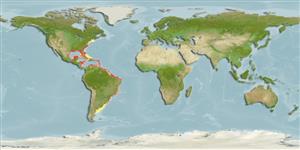Common names from other countries
Classification / Names / Names
Namen | Synonyme | Catalog of Fishes (gen., sp.) | ITIS | CoL | WoRMS
Environment: milieu / climate zone / depth range / distribution range
Ökologie
Benthopelagisch; dH range: 27.5 - 35; tiefenbereich 0 - 68 m (Ref. 97531). Tropical
Western Atlantic: USA to Argentina.
Length at first maturity / Size / Gewicht / Alter
Maturity: Lm ? range ? - ? cm Max length : 14.1 cm CW Männchen/unbestimmt; (Ref. 367)
Carapace more than twice as broad as long; 9 teeth on broadly arched anterolateral margin (outer orbital tooth and strong lateral spine included); front not so advanced as outer orbital teeth, bearing, between the inner orbital angles, one pair of bicuspid teeth (resulting from the coalition of 2 separate pairs). Convex dorsal surface finely granulate, fissures on orbital margin broadly open; lower surface of carapace hairy; pincers moderate-sized; legs rather short and broad, densely fringed with hairs; fifth legs flattened in form of paddles. Basal segment of abdomen produced on each side into a strong, sharp, slightly upcurved spine. Color: dorsal surface, including pincers, light reddish brown to olive brown covered with many small, rounded white spots, tips of walking legs yellow; color pattern persisting in alcohol.
Minimum carapace width: 2.28 cm (Ref. 93549). Inhabits shallow water along ocean sand beaches and is well adapted to life in the waves and shifting sand; usually in bottom burrows at daytime and emerges at night, at temperatures of 27.5 to 28.6°C and salinities of 27.5 to 35 ppt. Presumably feeds on a variety of items including mollusks, other bottom invertebrates, and some fishes, carrion and detritus (Ref. 367).
Life cycle and mating behavior
Geschlechtsreife | Fortpflanzung | Ablaichen | Eier | Fecundity | Larven
Ovigerous females have been reported from May to September.
Tavares, M. 2003. (Ref. 367)
IUCN Rote Liste Status (Ref. 130435)
CITES Status (Ref. 108899)
Not Evaluated
Not Evaluated
Nutzung durch Menschen
Fischereien: weniger kommerziell
| FishSource |
Tools
Internet Quellen
Estimates based on models
Preferred temperature
(Ref.
115969): 22.5 - 28, mean 25.6 (based on 452 cells).
Preiskategorie
Unknown.
